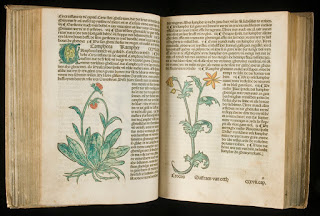Der Gart Gesundhiet
Peter Schoeffer
•Born 1425 – Died 1503
•Born in Gernsheim,
Germany, located on the Rhine.
•Died in Mainz, in
antiquity, it was a Roman fort city, which commanded the west bank of the Rhine
•An
early German printer.
•In
435 chapters, 382 plants, 25 drugs from the animal kingdom and 28 minerals are
described.
•Included
a section of Uroscopy.
•Published
for Bernhard von Breidenbach
(1440-1497), a wealthy Mainzer
canon.
•The
author (compiler) of Gart was
the Frankfurt city physician Johann Wonnecke of Kaub (1430-1503 / 04).
•Erhard
Reuwich of
Utrecht had some of the illustrations made.
•1st Edition 1485
•For
the first time in Germany Latin and Greek were abandoned and it was published
in German.
•This
herbal relied not on the work of the previous illustrators, but the
illustrations were from observation of the plants in nature.
•Out
of the 379 woodcuts, around 65 are based on the plants themselves which was a
high propotion at
the time.
•Der Gart was
written in a way to make it easier for the readers to navigate. It offered its
readers an alphabetical listing of every disease or ailment known and then a
reference to the chapter to find the remedy.
•A
list of the simples included where listed alphabetically as well as by their
chapter numbers.
•Considered
a great work that contained all the medical knowledge of the time.











